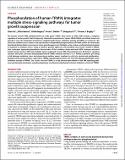Phosphorylation of human TRM9L integrates multiple stress-signaling pathways for tumor growth suppression
Author(s)
Ramos, Jillian; Begley, Ulrike; Fu, Dragony; Begley, Thomas J.; Gu, Chen; Dedon, Peter C; ... Show more Show less
Downloadeaas9184.full.pdf (3.252Mb)
PUBLISHER_CC
Publisher with Creative Commons License
Creative Commons Attribution
Terms of use
Metadata
Show full item recordAbstract
The human transfer RNA methyltransferase 9–like gene (TRM9L, also known as KIAA1456) encodes a negative regulator of tumor growth that is frequently silenced in many forms of cancer. While TRM9L can inhibit tumor cell growth in vivo, the molecular mechanisms underlying the tumor inhibition activity of TRM9L are unknown. We show that oxidative stress induces the rapid and dose-dependent phosphorylation of TRM9L within an intrinsically disordered domain that is necessary for tumor growth suppression. Multiple serine residues are hyperphosphorylated in response to oxidative stress. Using a chemical genetic approach, we identified a key serine residue in TRM9L that undergoes hyperphosphorylation downstream of the oxidative stress–activated MEK (mitogen-activated protein kinase kinase)–ERK (extracellular signal–regulated kinase)–RSK (ribosomal protein S6 kinase) signaling cascade. Moreover, we found that phosphorylated TRM9L interacts with the 14-3-3 family of proteins, providing a link between oxidative stress and downstream cellular events involved in cell cycle control and proliferation. Mutation of the serine residues required for TRM9L hyperphosphorylation and 14-3-3 binding abolished the tumor inhibition activity of TRM9L. Our results uncover TRM9L as a key downstream effector of the ERK signaling pathway and elucidate a phospho-signaling regulatory mechanism underlying the tumor inhibition activity of TRM9L.
Date issued
2018-07Department
Massachusetts Institute of Technology. Department of Biological EngineeringJournal
Science Advances
Publisher
American Association for the Advancement of Science (AAAS)
Citation
Gu, Chen et al. “Phosphorylation of Human TRM9L Integrates Multiple Stress-Signaling Pathways for Tumor Growth Suppression.” Science Advances 4, 7 (July 2018): eaas9184 © 2018 The Authors
Version: Final published version
ISSN
2375-2548